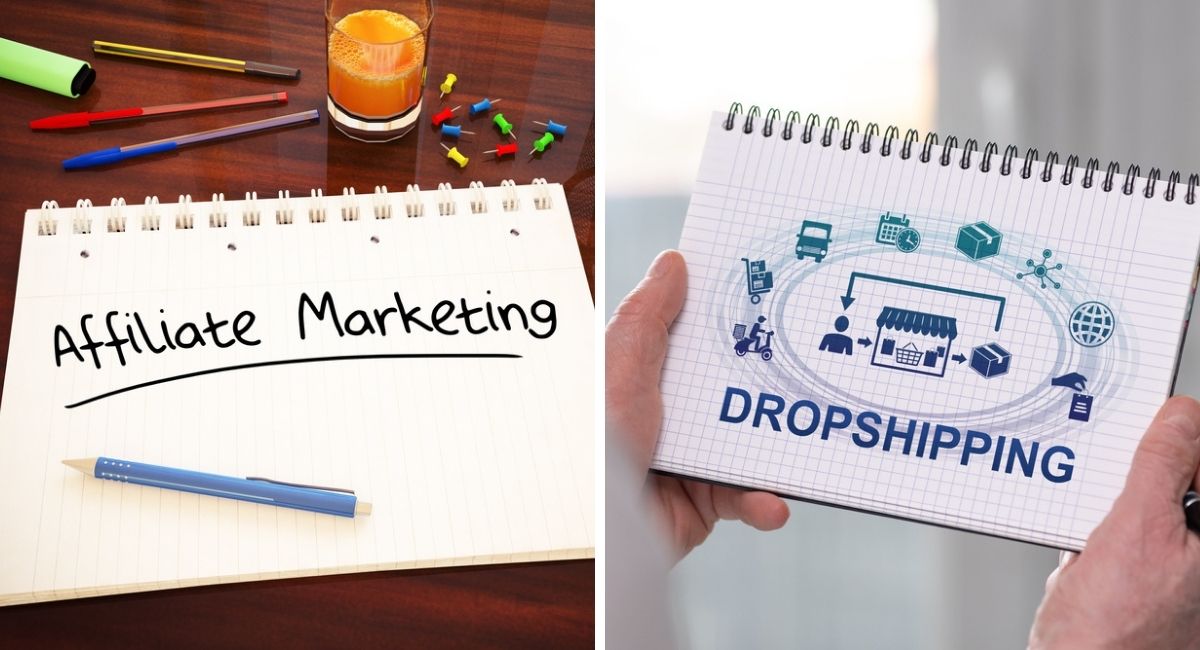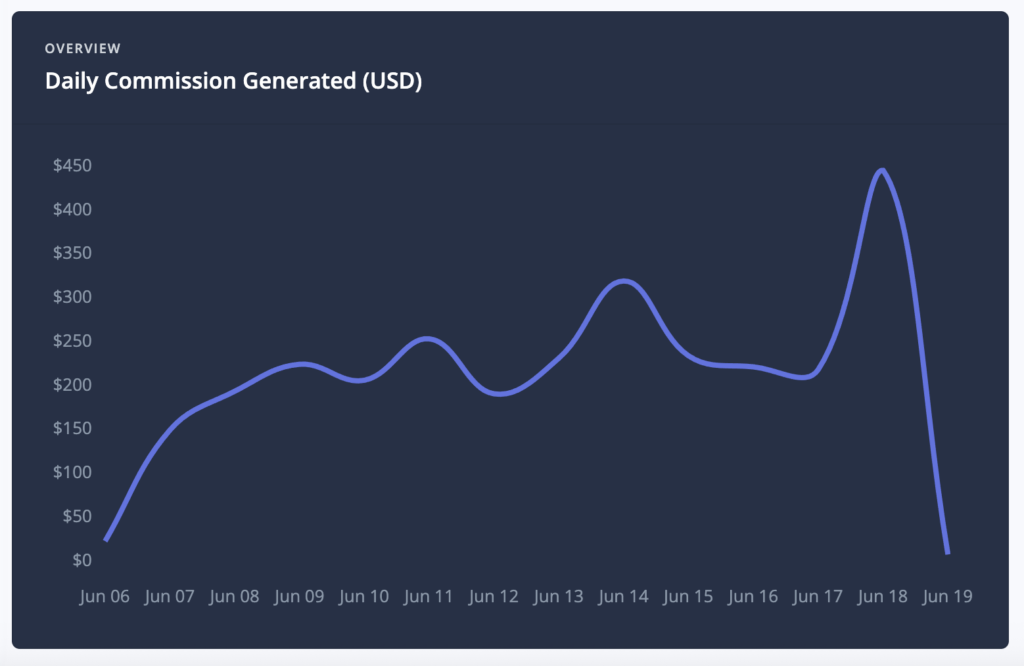Are you trying to choose between affiliate marketing vs dropshipping for your next business model?
Both are respectable, sustainable, and have the potential to earn you a good living.
However, choosing between the two can be a challenge because you see success stories of people crushing it using either of the two methods.
So, how do you choose?
You’re about to get the low down for dropshipping and affiliate marketing. First, we’ll discuss the pros and cons, and then we’ll answer the questions you have regarding both of them.
Let’s get to it.
Affiliate Marketing vs Dropshipping Breakdown
Affiliate marketing and Dropshipping are two common ways to make money online.
Both have good profit-making potential, require low start-up costs, and you can get started quickly with them both.
While they have similarities, they are also quite different.
| Dropshipping | Affiliate Marketing | |
|---|---|---|
| Low-Cost Start-up | Yes | Yes |
| Physical Stock | No | No |
| Writing Skills | Slightly | Yes |
| Passive Income Possible | No | Yes |
| Website Needed | Yes | No (recommended) |
| eCommerce Knowledge | Yes | No |
| High Earning Possibility | Yes | Yes |
| Low-Risk Business | Yes | Yes |
| Courses Available | Yes | Yes |
What Is Dropshipping?
Dropshipping is a fulfillment business where the owner uses a third-party supplier to hold and ship the products they sell. Typically they’re set up as an eCommerce store to sell products related to a specific niche market.
When they receive an order, they take payment and customer details and then pass this information on to the third-party supplier to send out the goods.
The dropshipper pays the supplier a lower cost than the customer and profits from the difference.
Take a look at the example below:
Billy owns an eCommerce website selling treadmills. A customer visits his website and purchases a treadmill for $600. The money is transferred to Billy’s bank account almost immediately.
He takes the payment and delivery details for the customer and visits the third-party supplier website (a manufacturer selling treadmills), and purchases the same treadmill the customer wants for $550 (a special price for dropshipping clients).
The manufacturer sends the treadmill out using the brand name of Billy’s business, and the transaction is complete.
Billy makes $50, and as far as his customer is concerned, it’s his business supplying the product.
What Is Affiliate Marketing?
Affiliate marketing is similar in that you don’t own the product. Still, the main difference between the two is you only have to send people over to the product owner’s website via a unique link (i.e., your affiliate link).
If they purchase a product or service, you receive a commission.
The affiliate link used is unique to you, and the product owner can track who you are and provide payment when someone purchases a product.
Here’s another brief example:
Mary has a website that reviews hosting providers online. A website visitor reads one of her reviews and clicks on the link at the bottom of the review, which takes her to the hosting company’s website.
The link the reader clicked on was her affiliate link, and when the visitor purchases a hosting plan, she receives a one-time cash reward or a monthly recurring commission.
5 Main Benefits of Dropshipping
Dropshipping has many benefits, so let’s look at some of the main ones that make this business model appealing.
1. Low-Risk Business Model
Dropshipping is low risk because you only spend money when you make a sale, and the money you’re spending isn’t yours; it’s the customers.
It’s also low-risk because the start-up costs for your business are pretty low.
You need a website, domain name, and a supplier who gives you the products at a cheaper cost than the general public
2. Set Your Prices
You can set your prices high or low with dropshipping. If you want a high-profit margin, you can raise your price, or if you’re hoping to make faster sales, you can charge less than the competition.
3. You’re Building Your Brand
As mentioned above, the supplier will send out the products with your business name and details as if it’s coming directly from you.
It’s a great way to build your brand and popularity over time.
4. Sell Large Products
Imagine you’re selling beds and not using a dropshipping supplier. You will need to have storage space to store the beds, which can raise costs and cause various other issues.
However, if you use a dropshipping manufacturer, they hold the products for you, so you can sell any item you want regardless of the size.
5. You Can Scale Your Business
Businesses can start small, selling a few items each week, but then scale it up to sell hundreds, even thousands of products.
You can start as a one-person business, and when you start to see success, you can add staff to help you out and even open a showroom to highlight the main products you’re selling.
5 Negatives of Dropshipping
There are some negatives to dropshipping, and it’s essential to be aware of them before starting.
Here are a few of them:
1. Reliant On Third-Party Suppliers
You have no control over the company, which can cause unforeseen problems. For example, you could be selling a product regularly on your site, and suddenly the supplier discontinues the item.
Or worse, you could be doing well, and the supplier goes bust, leaving you with no way to send the items on order.
2. Customer Service Is Your Responsibility
As the supplier will be sending out the product in your name, it will be your responsibility to deal with customer service.
It may seem simple at first, but over time, especially if you start making many sales, you will get more inquiries for advice, complaints, returns, and delivery.
3. Returns Can Be A Pain
If a customer wants to return an item, it can become a hassle because you will want to keep the customer from knowing you’re effectively a middleman. You also have to get the refund from the supplier and pass this on to your customer.
4. Profit Margins Can Be Small For Certain Products
If you’re selling a popular product, you’ll notice that other sellers are selling the item with lower profit margins. It can become frustrating because you will often need to sell many items to see a decent profit, which can cause a lot of work for little results.
5. Shipping Time Can Be Long
If you sell large items, or your supplier is from China or another country, you will typically come across long shipping times. While you can be upfront with your customers about this, it still puts people off, and you will lose sales.
Another negative knock-on effect is receiving more customer service emails asking when the item will be delivered.
7 Main Benefits of Affiliate Marketing
Like dropshipping, affiliate marketing also has many pros, and below are a few of the stand-out benefits.
1. Free To Get Started (Kind of)
Technically, affiliate marketing is free to get started — all you need is your affiliate link.
However, typically, it’s more of a low-cost operation because you’ll want a website (or landing page) and various other tools such as an autoresponder.
Most affiliate programs won’t charge you to join the program, although you will occasionally come across one or two that only use affiliates who have purchased the product they’re selling.
2. Multiple Ways To Promote
Another plus with affiliate marketing is the number of methods available to promote your affiliate links. You can use free methods like blogging, social media, and youtube, or paid methods like Facebook ads, banner ads, and Bing.
3. You Don’t Deal With Customer Service
Unlike dropshipping, you don’t deal with customer service concerning the product.
All you need to do is get people to visit the product owner’s website via your link, and if they purchase, they deal with queries, returns, shipping, and complaints.
Not having to deal with customer service is often the deal-breaker when choosing between affiliate marketing vs dropshipping.
4. Decent Commission Rate (Especially For Digital Products)
Physical products usually provide a commission rate of below 15%; however, if you’re promoting a digital product, this can rise significantly.
65-75% is typical for digital products, but don’t be surprised if you come across 100% commissions on some front-end products.
5. Affiliate Marketing Can Lead To Passive Income
Making passive income is the dream for many marketers, and the good news is it’s possible with affiliate marketing.
Your visitor signs up to your email list (usually because of a free incentive), and you then drip-feed emails related to your niche. The emails contain your affiliate link and get sent out automatically, even while you sleep.
You will have to use a landing page and an autoresponder with pre-filled emails (containing your affiliate link) to send out over weeks, even months.
6. Lots of Affiliate Marketplaces, Products & Services to Promote
Affiliate marketing is popular and you can find an affiliate program for almost any niche market you can imagine.
Here’s a brief list of affiliate marketplaces:
- Clickbank
- JVzoo
- CJ (Formally Commission Junction)
- Awin
- ShareASale
- Amazon Associates
7. High Multiples When Selling The Website
While the potential to generate high revenue while operating the website is there, another option for a nice payout is to flip the website.
By selling the website, you receive a one-time lump sum payment using the last 6-12 months of average profit. For example, if you generate $1,000 per month in profit, you can sell for around 35 to 45 times the profit. This equates to a sale valuation of $35,000 to $45,000. The exact valuation depends on the site history, traffic and revenue diversification, SEO history, and more.
There are many buyers out there looking to buy quality affiliate marketing websites.
3 Negatives of Affiliate Marketing
It would be amiss if I didn’t mention the negatives of affiliate marketing because, like dropshipping, there are some cons to the business model.
Here they are.
1. Reliant On Third-Party Products
You’re selling a hundred products per month and earning a few thousand dollars in profit, and life seems sweet, but suddenly, the product owner decides to close the website and move in a completely different direction — yes, overnight your money stops!
This is the risk you take when becoming an affiliate marketer, and although not common, it does happen.
2. Earnings Threshold Before Payment
Some product owners or marketplaces will only pay out after you earn a set amount of money. For example, Generate Press has a great affiliate program, but you have to earn $100 before they pay you out.
It’s not really an issue if you’re sticking with them and hoping to sell many products, but for one sale, you won’t have enough to withdraw your earnings.
3. The Vendor Sets The Commission Rate
The vendor sets the amount of money they pay you, and you have no control over this unless you’re in a position to haggle with them.
If you’re just starting and they pay 65%, you’re earning 65%; however, if you’ve been selling many products for a while, you can drop them an email and negotiate a higher commission.
Most product owners will be open to this because they recognize how much you are making them — they may even offer a bonus!
Affiliate Marketing vs Dropshipping FAQs
We’re coming to the end of the article now, and hopefully, you’re starting to understand the differences between affiliate marketing and dropshipping.
Before making a decision, take a look at the faqs below.
Can you make a living with dropshipping?
Yes, there are plenty of people making a living from dropshipping. Irwin Dominguez is a prime example and earned 1 million dollars in just eight months from dropshipping.
There are plenty of others too.
Can you make a living with affiliate marketing?
Yes, affiliate marketing has been making marketers incredible amounts of income for many years, and many are doing it as their primary source of income.
For example, Pat Flynn has earned over 3 million dollars in affiliate revenue after losing his day job.
Is affiliate marketing still profitable in 2022?
Affiliate marketing is still thriving in 2022 and will be for many years. The trick is to do things correctly, stick to the rules, and have the correct disclaimers on your website.
Final Thoughts & Actionable Takeaways
Affiliate marketing and dropshipping are genuine business models that can make you an honest living. Neither of them is a push-button success method and you’ll need to work hard, especially at the beginning.
If you learn about the model you choose, you should start to see success over time.
If I had to select the best model, I would say affiliate marketing because of the sheer amount of products available and the bonus of not being concerned with customer service.
However, they’re both worth considering.
Here’s a list of the actionable takeaways for affiliate marketing vs dropshipping:
- Affiliate Marketing & dropshipping are both great business models capable of making an honest living
- Although they have similarities, they are also quite different
- Both are low risk and low cost to get started
- Affiliate marketing has the potential to produce passive income and is still profitable in 2022

Jon Dykstra is a six figure niche site creator with 10+ years of experience. His willingness to openly share his wins and losses in the email newsletter he publishes has made him a go-to source of guidance and motivation for many. His popular “Niche site profits” course has helped thousands follow his footsteps in creating simple niche sites that earn big.






